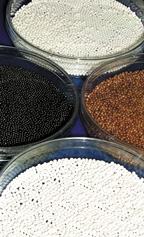
As grinding requirements become finer and more specialized, and other issues such as material contamination become more important, it is increasingly important to evaluate the type of grinding media used in your mills. These new requirements have resulted in advancements from many mill manufacturers, including Premier Mill, who have developed newer, high-energy grinding-mill configurations. Very simply, these new high-energy designs demand a better grade of grinding media.
To evaluate grinding media, the following characteristics must be analyzed:
- Chemical composition of the grinding bead,
- Manufacturing and forming process of the bead,
- Surface conditioning of the bead, and
- Size range or gradation of the bead.
What are some of the important features and benefits of the new generation of high-quality ceramic grinding beads?
- Smooth Bead Surface — can reduce mill-component wear and is more easily washed between formulations.
- Solid Composition — eliminates hollow beads or surface satellites that can break during processing, causing clogged screens and mill-component wear.
- Excellent Roundness — increases efficiency and maximizes shear inside the milling device.
- Uniform Narrow Size Distribution — increases efficiency and results in more narrow particle-size distributions in finished product, reducing media wear.
- Higher Density — can result in increased grinding efficiency in discrete-pass or recirculation grinding, reduced processing times, higher throughputs, and the ability to process higher-viscosity formulations.
- Consistent Microstructure Composition — improves hardness and toughness for long media life, resulting in less downtime.
In many cases, using a higher-quality and higher-cost grinding bead can produce great long-term benefits that easily justify this higher initial cost. Benefits such as increased grinding efficiency are easy to demonstrate. If the mill can produce 10% or 20% more product in the same time, the dollar value of this can easily be tabulated. The goal is always to get more gallons through a smaller grinding chamber without damaging the mill.
Other benefits are harder to quantify. For example, using a higher-quality grinding bead will usually result in a longer cycle of consistent production in the plant. If the mill produces the same desired finished particle size over a longer time cycle, a definite savings will be realized. The curve of quality vs. hours of operation will flatten out. Quality-control time cycles can be increased, and samples don’t have to be checked as often.
You can reduce the yo-yo effect in manufacturing. When the process is constantly changing as media and mill parts wear, quality control is a moving target. Steadying the target can reduce the stress levels of process engineers and production managers everywhere.
Mill maintenance costs will usually be reduced when a higher-quality grinding media is used. The result will be longer mean time between failures (MTBF). For example, if the preventive-maintenance cycle can be increased to 2,000 hours instead of 1,000 hours, this means the mill is torn down for maintenance half as frequently. This change in MTBF has a definite average cost associated with it — both in downtime (lost production) and maintenance costs for replacement parts and labor.
When viewed in this long-term context, the initial cost of grinding beads should be the least-significant factor in your media-selection process. In other words, lower cost per pound of beads can result in a significantly higher cost per pound of finished goods produced when a long-term production analysis is done.
Improved grades of ceramic grinding media are available in zirconium silicate, cerium-stabilized zirconium oxide and yttrium-stabilized zirconium silicate. These high-quality ceramics should be evaluated if issues such as high efficiency, ultra-fine particle size, minimum contamination and reduced mill maintenance are critical to your company. The accompanying table gives some examples of new, high-quality ceramic grinding media that are most commonly used in horizontal, vertical and submersible basket-type media mills for pigment dispersions and slurry-grinding applications.
If you are currently using lesser grades of ceramic or even glass media, you have a great deal to gain by testing these new offerings. The effect on your product quality, productivity and mill-maintenance costs can be very significant.
Today, Premier Mill, an ISO 9001-registered company, is known globally for the quality and the high-performance standards of the process equipment and systems we design and manufacture. We’ve been in business for over 75 years. And throughout those years, we’ve had but one clear priority: to continue providing the best process solutions and highest-quality equipment to our customers.
For additional information on media mills, contact Premier Mill, One Birchmont Dr., Reading, PA 19606-3298; phone 610-779-9500; fax 610-779-9666; e-mail Sales@PremierMill.com; or visit the Web site wwwpremiermill.com.
